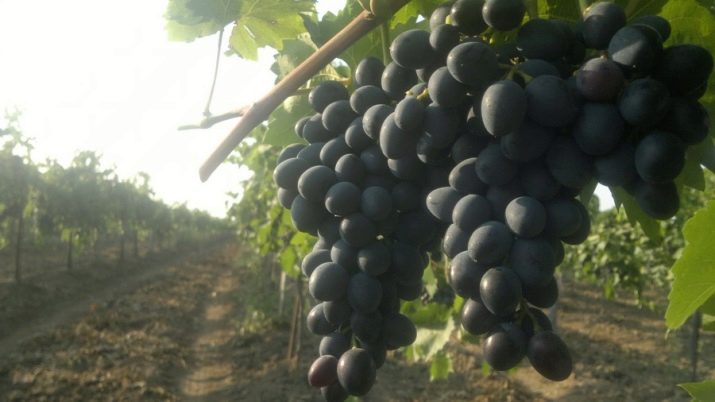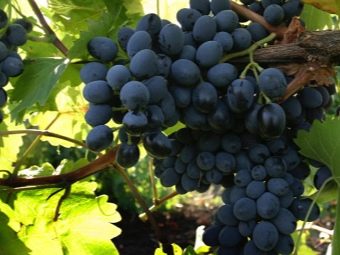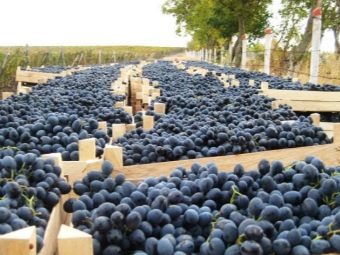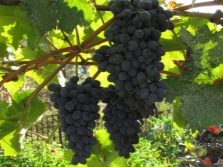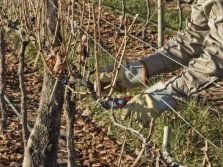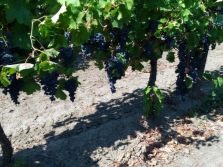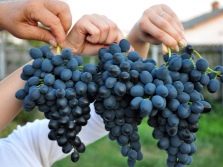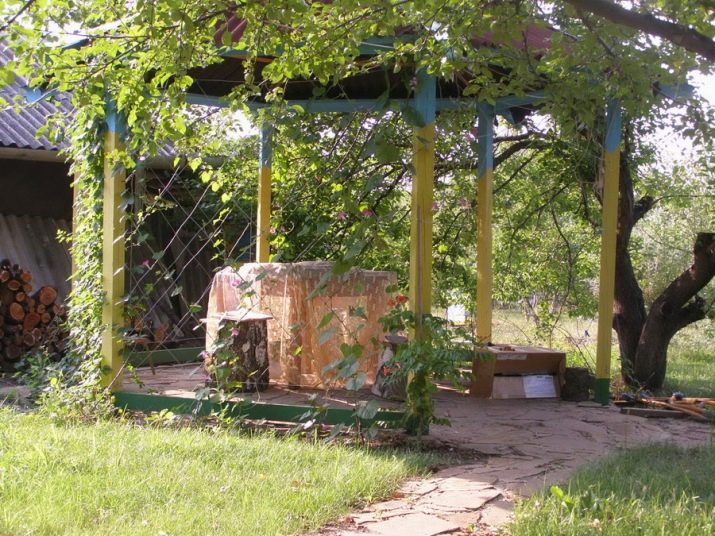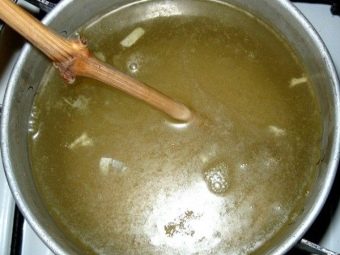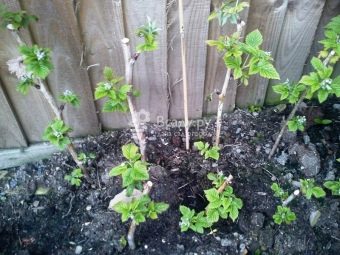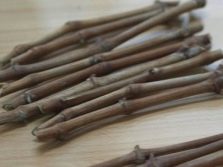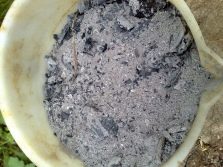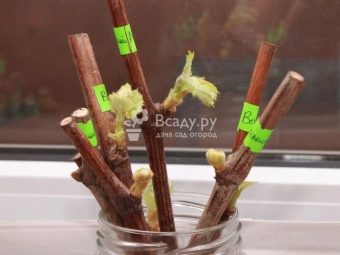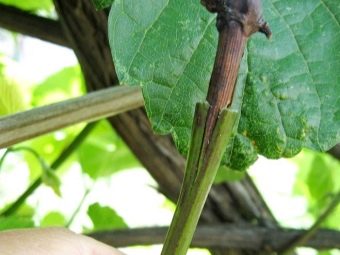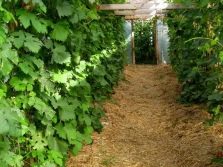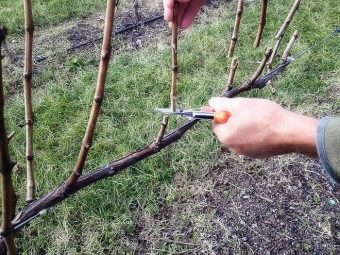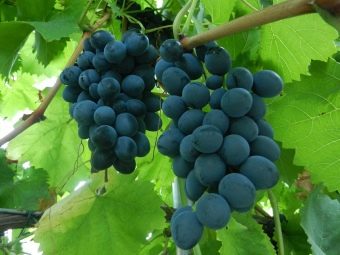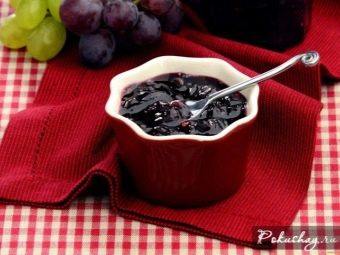Moldova Grapes: planting and care rules
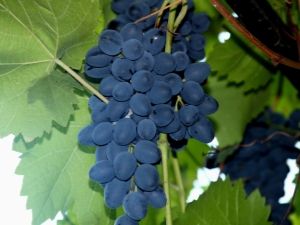
In our country there is not a single fan of grapes who do not know the table variety Moldova, distinguished by its unpretentiousness and resistance to bad weather and diseases.His vine does not have huge clusters and large berries, but its fruit tastes excellent.
Special features
The variety "Moldova" is bred by breeders. Its progenitors are "Guzal Kara" and "Save Villar 12-375". It has been popular for decades. Has increased consumer demand. Such grapes grow in Moldova, Ukraine, and in Russia it feels best in the south of the country. Not very well take root in the central regions. When planting in the northern regions of the country due to the lack of heat the final ripening of the berries does not occur, so they remain acidic. In some regions, this variety is called "Codryanka Late".
The vegetative period - from the moment the leaves appear and before the harvest, ranges from 150 to 160 days. With proper agricultural technology, the yield of “Moldova” reaches 160 centners per hectare. After reaching the age of 8-10, up to 150 kg of crop can be harvested from one bush. After planting, the fruiting of the plant begins in the second or third year. Those who like to grow grapes in their summer cottages can yield up to 4 kg per square meter. m
The vine grows very intensively and quickly enters the fruiting stage. At 5 - 7 knots from the main vine the most intensive fruiting occurs.
Shrubs "Moldova" very quickly grow and thicken greatly, but this should not be allowed. It is necessary to monitor and timely put the vine in order. Thickening greatly affects the ripening time and quality of the crop. It is necessary to form a bush in long sleeves. Without providing proper care and formation of the bush, it is impossible to achieve a good harvest from the variety “Moldova”. With a strong thickening, the absence of irrigation and fertilizing with fertilizers, the berries will shrink from year to year, and it will be difficult to get a good crop.
Clusters of the Moldova variety are distinguished by a neat and very beautiful conical shape. The variety does not have large clusters. On average, they weigh 300 grams, although there have been cases when clusters from bushes over 12 years old reached a weight of one kilogram. A characteristic feature of the variety is that the clusters are not very dense. The usual weight of a berry is 6-7 grams, its length is no more than 2.2 cm, the width reaches 1.9 cm. The pulp of berries is fleshy. They contain from 2 to 4 seeds.
To taste the grapes are sweet. The longer it is stored, the better the taste becomes due to a decrease in acidity. Tasters rate the variety "Moldova" for its taste for 9 points. The peel of the berries has a very dark purple color. It is dense with a characteristic bloom of wax. The density of the berries gives the grapes the ability to carry long-term transportation and a long shelf life - up to 160 - 180 days.
Grapes canned berries, they make excellent compotes and preserves. In Moldova, this variety is used in winemaking; well-known famous Moldovan wines are made from it.
Advantages and disadvantages
The flowers of “Moldova” are bisexual, they are self-pollinated, so the owner should not worry about planting additional bushes for pollination.
Grape clusters can be on the vine until frost. After their removal from the vine, they are stored for a very long time.
In the south of the country, the variety winters beautifully without shelter, the plant has high frost resistance and can withstand temperatures down to minus 23 degrees.
Vine recovers quickly after pruning. The disadvantages of the variety include the fact that "Moldova" is affected by powdery mildew. For the prevention of this disease, it is necessary to spray the plant twice per season.
If you do not remove the clusters from the bush for a long time, then the shelf life of the berries is significantly reduced, so you should not delay with this and harvest the plants from them in time.
How to plant?
For planting a light and well-fertilized soil is required. Land for planting grapes should have a drainage system. In the presence of groundwater at a level of 1.5 meters to plant the ground grapes does not make sense - it will not take root.
When choosing a site for planting, if possible, one should prefer the place where there is an abundance of sun and there are no northerly cold winds. A very convenient place for planting is near the gazebo, where the vine will not be able to thicken much.
Experienced gardeners are engaged in cuttings both in autumn and in spring. Grapes are propagated in two ways: grafting on their own roots and grafting on an old stock. For the best rooting of all cuttings, they should be placed briefly (for 1 - 2 seconds) in a solution of “Gumanat” (10 drops of the drug per 1 liter of water). Planting cuttings produced in the prepared and well-fertilized soil. It is necessary to dig up the ground well, mix it with organic fertilizers, form a small indentation, cover it with a layer of earth (so that the cutting roots do not come into contact with the fertilizer) and carefully plant. The root neck should not be deepened; it should be placed above the ground.
If you buy cuttings as planting material, then you need to pay attention to the quality of the roots. Planting cuttings into the ground from the branches, which you yourself cut from the vine, should be made with previously germinated roots. When planting in the fall, the top of the cutting should be coated with paraffin. This procedure will help him to survive the winter. In boiling water paraffin is added, which will be on the surface of the water. For a moment, a cutting is dipped into it, which is immediately placed in cold water for cooling. Planting such cuttings into the ground should be carried out at a stable temperature regime in the range of +15 degrees, and the soil temperature should not be below +10.
Nature has given the plant the opportunity to develop both on pieces of the trunk, which have already matured and covered with bark, and on green shoots. You should know that when cutting the branches under the cutting the cut must be green. Virtually all cuttings (chubuki), prepared in the fall, when they are planted in the spring, take root well. The plant of the autumn planting material is very strong, quickly gives roots, leaves and future fruit-bearing arrows. Harvesting autumn cuttings produce after all the leaves fall off. Fruiting branches with brown bark cut a length of at least 30 cm with the presence of 2-4 eyes. Chubuk diameter should not exceed 6 mm. These blanks are stored until February in the cellar in a box with wet sand or buried in a garden in a trench 50 cm deep. Cuttings can be stored in a plastic bag in the refrigerator door - this is the temperature suitable for them.
In February, to obtain the first roots up to 2 cm in length, the cuttings are placed in wet sawdust, soil or water. Then land in separate containers. In plastic cups (10 cm in diameter, 25 cm in height), holes are made from the bottom, a drainage layer is laid out of a brick or pebbled stone, and then filled with the prepared mixture of sand, peat and humus. Cuttings are planted in the ground at an angle, with 1-2 buds above the ground. One week after the appearance of the roots, wood ash is fed in the amount of 30 g per plant. By early May, before planting, the cuttings should give small leaves.
For the preparation of grafts for rootstocks should be prepared graft. It is a cutting, cut from the bottom at an angle. Such a wedge should be a few millimeters from the peephole. The prepared cutting is placed in water for a day. An old cut-off trunk with roots, in which an incision is made, will serve as a stock for it. A prepared graft wedge is inserted into the gap formed. Rapid accretion with each other contributes to tight compression with the help of twine. After planting, the cutting and stock is watered with plenty of water (at least three buckets).
How to care?
For the variety "Moldova" soil moisture is important. Abundant watering is required a week before flowering and as soon as the berries begin to tie.If the spring is dry, then watering should be done immediately after the appearance of the first leaves, and in the fall should be watered after harvest. In the dry summer the vineyard will not do without regular watering. In order to avoid stagnation of moisture, the owner must provide drainage ditches.
Around the plant the ground is mulched with straw, humus. Mulch is necessary for protection from the scorching sun, as well as to ensure that the soil does not dry out and is longer wet. Cover the ground around the plant should be 1 - 1.5 meters in diameter, the layer thickness should not exceed 5 cm. Mulching is carried out only in spring and autumn. In the summer, the mulch is harvested, since on hot days it will adversely affect the roots.
In the south, the variety is not covered before winter. In other regions, young plants bend and cover with a film before hibernation, pressing them with arcs. The trunks of plants older than four years are connected with each other and bend down to the ground. Above put lapnik pine plants or harbor structures from the boards. The stalk, planted in the fall, must be completely covered with earth.
Pruning can be done in very early spring, while the vine is at a resting stage. A properly shaped vine is one that consists of four long sleeves. In the spring, it is necessary to make sure that on each branch, departing from the central trunk, there are not more than 7 (maximum 9) buds, everything else must be removed. With a high stamp of the eyes should not be more than 5-6 pieces. For this variety is very important load plants in clusters. With the formation of a large number of clusters should remove excess small forming clusters.
The application of mineral fertilizers must be done three to four times per season. In the spring plants need nitrogen, and in the summer potassium and phosphorus. Organic fertilizers affect the taste of grapes, so they are made only after harvested.
In terms of diseases and pests, the variety is very convenient for cultivation. Moldova is not at all afraid of the gray rot that other grape varieties are prone to. The root system does not suffer from phylloxera. A feature of the variety is that the wasps do not affect the berries at all. "Moldova" is sick with powdery mildew, fomopsis, lime chlorosis, from which it is necessary to carry out prevention.
It is necessary to draw up a spraying scheme, according to which it should be carried out at least twice a season with Bordeaux mixture (concentration no more than 1%).
Recommendations and feedback
Grapes "Moldova" is estimated by gardeners only positively. They say that the grade deserves due attention and it should be planted on the site. Gardeners noticed that the size and taste of berries are very dependent on the weather. In a very hot summer, the fruits are very sweet and large. In the rainy cold season, they are more acidic and smaller. Berries gardeners make juices, jam and homemade wine.
Buyers admire this variety, in their opinion, it is beautifully stored and has a pleasant taste.
The hostesses recommend the excellent “Moldova” grape jam. It will appeal to all your loved ones and will become a homemade treat for the household. Jam can be made with stones, without them, with the addition of various fruits and berries, as well as with all sorts of spices. Already cooked jam is used as a filling for all kinds of baking.
To prepare this delicacy, only ripe fruits are needed. All berries must be whole, do not damage them. Well-washed grapes lay on a baking sheet, sprinkle with sugar, favorite spices and pour a little water on top. The oven is preheated to 150 degrees. Put the baking tray inside the oven and bake the ingredients for an hour. Then take the baking sheet out of the oven and leave to cool for two hours. During this time jars with lids are sterilized. Cold cooking decomposes and rolls. A treat for winter is ready. It should be stored in the cellar.
“Moldova” is a very good variety for industrial wine production, and for summer residents who do not have much time to take care of their country site, it will be an excellent option for growing tasty grapes.
Review of Moldova grapes in the next video.

